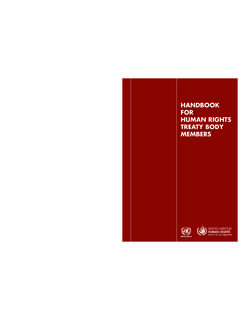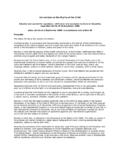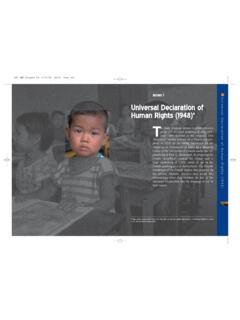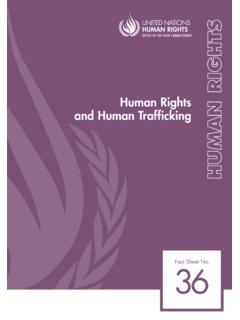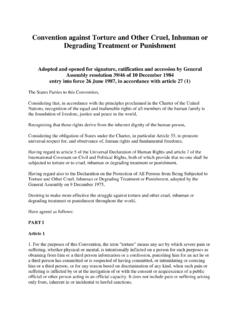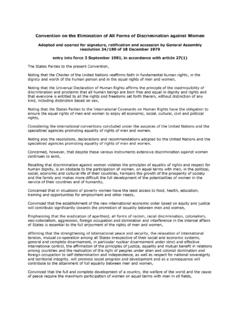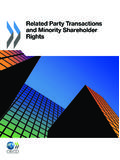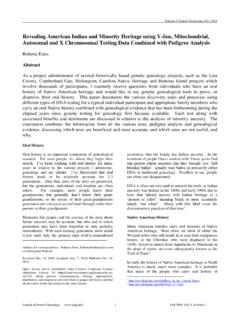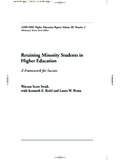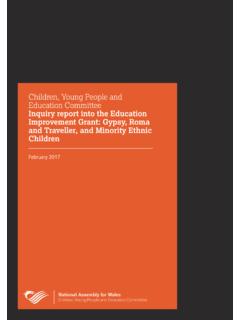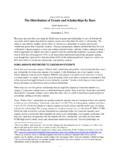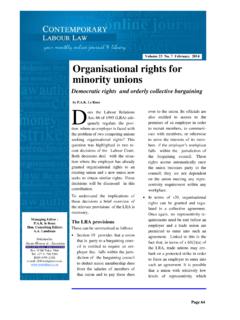Transcription of Promoting and Protecting Minority Rights - OHCHR
1 Promoting and ProtectingMinority RightsA Guide for AdvocatesDesigned and printed at United Nations, Geneva 1340538 (E) November 2014 3,452 HR/PUB/12/7 United Nations publications Sales No. ISBN 978-92-1-154197-7 Promoting and Protecting Minority RightsA Guide for AdvocatesGeneva and New York, 2012ii Promoting AND Protecting Minority RIGHTSNoteThe designations employed and the presentation of the material in this publication do not imply the expression of any opinion whatsoever on the part of the Secretariat of the United Nations concerning the legal status of any country, territory, city or area, or of its authorities, or concerning the delimitation of its frontiers or boundaries.
2 **Symbols of United Nations documents are composed of capital letters combined with figures. Mention of such a figure indicates a reference to a United Nations No. 978-92-1-154197-7eISBN 978-92-1-056280-5 2012 United NationsAll worldwide Rights reservedMinority Rights focus in the United Nations iiiForeword I am delighted that this publication, Promoting and Protecting Minority Rights : A Guide for Minority Rights Advocates, comes before you as we celebrate the twentieth anniversary of the adoption of the Declaration on the Rights of Persons Belonging to National or Ethnic, Religious and Linguistic Minorities.
3 This anniversary gives us the opportunity to look back on the 20 years of Promoting the Declaration and use that experience to plan and strategize for the future, to decide how best to bring this Declaration further to the fore of human Rights discussions taking place all over the world and discuss its implementation. It is our hope that the Guide will be a true vade mecum, assisting civil society to engage even more effectively in this important and immense task. Whether we are talking about democracy-building following the uprisings in North Africa and the Middle East or ensuring human Rights in the context of the global economic downturn; about sustainable development in the context of the 2012 United Nations Conference on Sustainable Development ( Rio+20 ) or about guaranteeing effective participation of minorities, including Minority women and girls, in all spheres of life, worldwide; Minority issues need to maintain their rightful place on the agendas of decision this anniversary year, my Office is increasing its engagement on Minority Rights even further.
4 We are organizing a series of subregional and regional events to address most topical Minority issues and we pursue a range of awareness-raising activities. We are taking the lead in the formation and coordination of the United Nations Network on Racial Discrimination and Protection of Minorities, a new platform aiming to enhance cooperation and dialogue on minorities across the United Nations system. All this is in addition to already established work on Minority Rights , which includes field-presence engagement on Minority issues, capacity-building for Minority Rights activists through the Minorities Fellowship Programme, supporting the mandate of the Independent Expert on Minority issues and the annual Forum on Minority Issues.
5 Please visit our website to make sure you have all the latest information on these activities. It is our role as human Rights defenders to ensure that the Rights of national or ethnic, religious and linguistic minorities are highlighted and taken into account. We hope that this Guide will prove to be a valuable tool for Minority Rights advocates, helping them place Minority Rights on the agenda, where this has not yet been done, or make sure they stay there and are adequately addressed. In the international, regional and national discussions framed by the all human Rights for all principle, we must work together to make sure that minorities are not left out.
6 Towards this end, the Guide explains, in a reader-friendly way, who are the main actors working on Minority issues in the United Nations and in key regional organizations, and what are the best ways of engaging enrich the societies of each and every country in the world. Through working on guaranteeing their Rights , our chief aims must be that no one will be afraid to self-identify as a member of a Minority , fearing disadvantage will come out of that decision; that persons belonging to minorities will be guaranteed protection of their existence and identity; and that they will benefit from the principles of effective participation and non-discrimination.
7 Let this publication guide us in working towards making this a reality for all persons belonging to minorities, PillayUnited Nations High Commissioner for Human RightsAcknowledgementsThe Office of the United Nations High Commissioner for Human Rights wishes to express its sincere thanks to Hurst Hannum, Professor of International Law at the Fletcher School of Law and Diplomacy, for his valuable contribution to the preparation of this Guide. In addition, special mention and thanks are due to our United Nations partners and regional organizations that have contributed to the Rights focus in the United Nations vContentsPageForeword.
8 IiiIntroduction .. 1 PART ONE Minority Rights FOCUS IN THE UNITED NATIONSC haptersI. Overview: development of Minority Rights in international law .. 2II. The Office of the United Nations High Commissioner for Human Rights .. 8 III. The United Nations Human Rights Council and its subsidiary bodies .. 21IV. The United Nations special procedures .. 30V. Human Rights treaty bodies .. 44 PART TWO OTHER RELEVANT BODIES IN THE UNITED NATIONS SYSTEMVI. The United Nations Development Programme .. 64 VII. The United Nations High Commissioner for Refugees .. 67 VIII.
9 The United Nations Children s Fund .. 72IX. The International Labour Organization .. 76X. The United Nations Educational, Scientific and Cultural Organization .. 80 PART THREE REGIONAL SYSTEMSXI. The human Rights system of the African Union .. 90 XII. The Council of Europe .. 102 XIII. The Organization for Security and Co-operation in Europe .. 123 XIV. The European Union .. 133XV. The inter-American human Rights system .. 143 AnnexesI. Core documents Declaration on the Rights of Persons Belonging to National or Ethnic, Religious and Linguistic Minorities .. 151 Commentary to the United Nations Declaration on the Rights of Persons Belonging to National or Ethnic, Religious and Linguistic Minorities of the Working Group on Minorities.
10 154II. Useful websites .. 171 Minority Rights focus in the United Nations 11 INTRODUCTIONT oday, issues related to the Rights of persons belonging to minorities may be found in nearly every human Rights instrument and forum. The United Nations and other intergovernmental organizations recognize that Minority Rights are essential to protect those who wish to preserve and develop values and practices which they share with other members of their community. They also recognize that members of minorities make significant contributions to the richness and diversity of society, and that States which take appropriate measures to recognize and promote Minority Rights are more likely to remain tolerant and present Guide offers information related to norms and mechanisms developed to protect the Rights of persons belonging to national, ethnic, religious or linguistic minorities.


